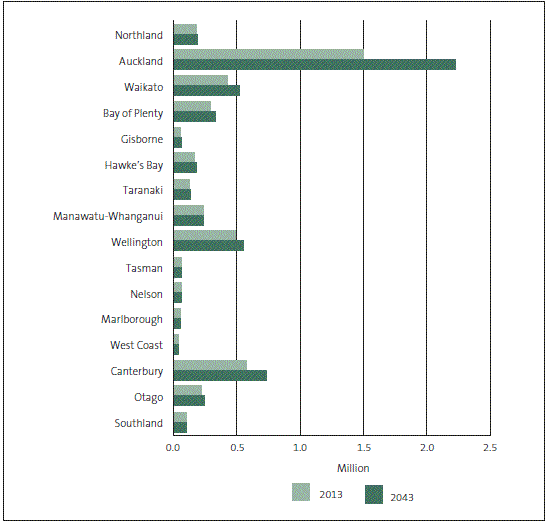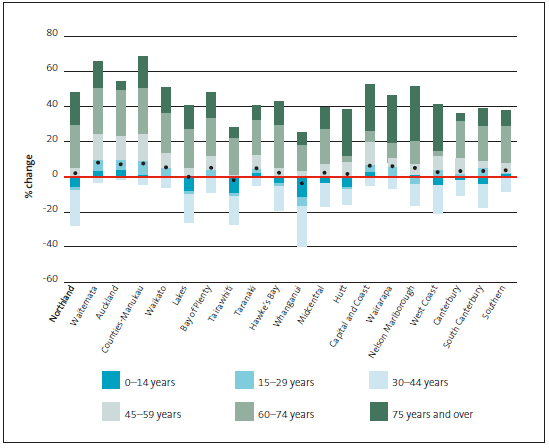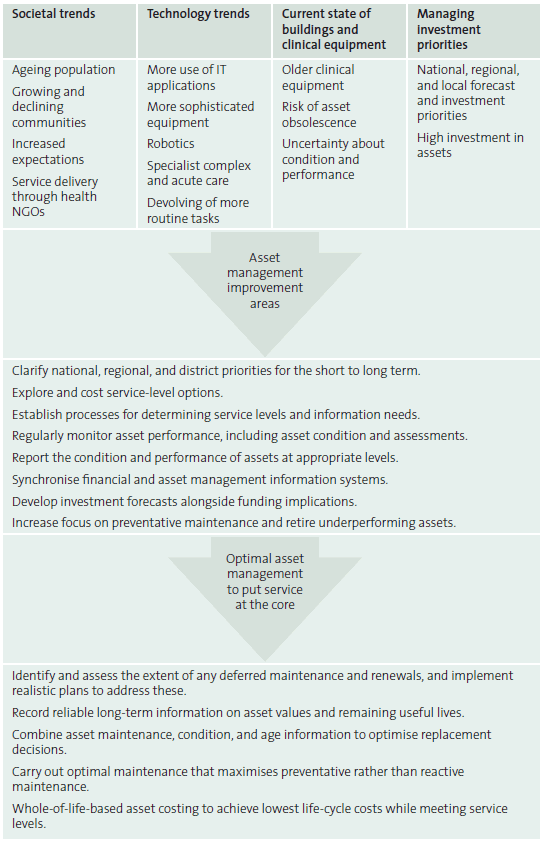Part 1: Introduction
Purpose and objective of this report
1.1
The Ministry of Health (the Ministry) required district health boards (DHBs) to prepare asset management plans in 2009. At that time, our auditors looked at how DHBs responded to the requirements. Since then, we have reported concerns about whether DHBs have the asset management information they need to support the delivery of health services that depend on assets.
1.2
In this report, we describe the results of the work we have carried out in response to our concerns. We looked at the 20 DHBs collectively to provide an overview of the state of DHB assets and the approach that DHBs are taking to managing them.
1.3
We took this approach because DHBs are the providers and purchasers for most public health services, which must operate as a national network of health services. However, because the circumstances and practices of DHBs vary, not every finding or comment we make applies to every DHB.
District health board asset management roles and responsibilities
1.4
DHBs have primary responsibility for making decisions about capital investment and asset management.
1.5
DHBs are grouped into four regions – Northern, Midland, Central, and the South Island. The DHBs in each region have established regional capital committees to guide regional capital investment.
1.6
Nationally, until March 2016, the National Health Board, supported by the Ministry, was responsible for matters such as funding and monitoring DHBs, overseeing their planning, and providing guidance on which services should be planned, funded, and provided nationally, regionally, and within each district.1
1.7
A specialist Capital Investment Committee is responsible for a centrally led process for the national prioritisation and allocation of capital investment in the health sector in future years.
1.8
The Treasury and the Ministry require DHBs to prepare 10-year capital intentions for projects worth $10 million and or more ($500,000 for projects related to information and communication technology (IT)). Preparing these intentions includes obtaining endorsement from regional capital committees and the Capital Investment Committee, and approval from the DHB's Board and the Ministers of Health and Finance for capital expenditure proposals.
1.9
DHBs are also required to comply with the Treasury's Better Business Cases process and the Capital Investment Committee's Capital Assessment Guidelines for:
- all capital investments in fixed assets that require Crown equity or new debt support;
- investment projects or programmes totalling $10 million or 20% of total assets, whichever is lesser; and
- investments that could strategically affect the performance of DHBs or investments that the State Services Commission has identified are of high risk.2
The context for our report
How societal and technological changes affect asset management in the health sector
1.10
During the period we were writing this report, the Ministry was leading an update of the Minister of Health's health strategy. The Ministry published a consultation draft – Update of the New Zealand Health Strategy: All New Zealanders live well, stay well, get well: Consultation draft (the Health Strategy Update) – and our references in this report are to the consultation draft. The updated strategy was published in April 2016.
1.11
The Health Strategy Update says that global challenges are shaping, and will continue to shape, New Zealanders' experience of health services.3 The Health Strategy Update identifies the following challenges:
- providing health and social services to increasing numbers of older people who are living longer;
- a growing burden of long-term health conditions, such as heart disease, diabetes, depression, and dementia;
- how to afford new technologies and drugs, and meet rising expectations;
- a highly mobile global workforce;
- the emergence of new infections and antibiotic resistance; and
- the health and social consequences of climate change.
1.12
Good information for decision-making is becoming increasingly important for the health system, which faces rapid technological development alongside increased and changing demands from New Zealand's ageing and urbanising population.
1.13
DHBs have significant physical assets, mainly buildings and clinical equipment. These are significant because they are needed to provide critical health services and because of their high monetary value. DHBs' physical assets were valued at $5.7 billion as at 30 June 2015.
How technology is changing health service delivery and asset needs
1.14
As part of preparing the Health Strategy Update, the Ministry commissioned an independent review of capability and capacity within the health system. This review emphasised the effect of digital technology on New Zealand consumers and the health system:
By 2025 the majority of the world's population will in one generation have gone from having virtually no access to unfiltered information to accessing most of the world's information through a device that fits in the palm of their hand. Further, all 13-year olds and younger are mostly digital natives and do not know a world without the Internet and its connected devices. This change will have profound and likely positive effects on the New Zealand health system, the roles of providers (both organisations and individual providers), and on the knowledge and demands of our consumers. Digital technology will change health institutions of all sizes and in all sectors from within and without. The most significant impact of the spread of communication technologies will be the way they help re-allocate the concentration of power away from the traditional power brokers in the system (i.e. DHBs, provider groups, individual providers), to consumers.
1.15
One theme (Smart system) of five strategic themes in the Health Strategy Update consultation draft was about:
- information being reliable, accurate, and available at the point of care;
- individual online health records that people are able to access and contribute to;
- data and smart information systems that improve evidence-based decisions, management reporting, and clinical audit;
- standardised technology that allows us to easily make efficient changes; and
- being able to take advantage of opportunities of new and emerging technologies.4
1.16
The Deloitte Centre for Health Solutions sees technology as a means of integrating hospital and community care, with hospital doctors and nurses running clinics and delivering care in the community and primary care staff providing services to community and specialist hospitals.
1.17
How health services are delivered affects the assets needed for these services. Overall, technology is expected to make contact between doctors and patients more virtual. It will also make more specialist complex and acute care possible, which will require more sophisticated equipment and facilities.
How social change is affecting health service delivery and asset needs
1.18
Figure 1 shows the 2013 Census results for the 16 regional council areas of New Zealand. All regions will have more people in 2043 than in 2013 to varying degrees.
Figure 1
Population of regional council areas in 2013 and projected population in 2043

Source: Statistics New Zealand
1.19
The Thirty Year New Zealand Infrastructure Plan 20155 forecasts that, between 2013 and 2043, the West Coast, Southland, Gisborne, and Manawatu-Wanganui regions will have the lowest rate of population growth at 1%. In contrast, Auckland's population is expected to grow by 33% during this period.
1.20
Generally, the number and percentage of people at older ages is expected to increase throughout the country. Even for areas with growing populations, the growth rate will slow during the projection period, as the population ages and deaths increase relative to births. However, Statistics New Zealand says that there will be considerable variation between areas, largely because of each area's current population age structure and different fertility and migration patterns.6
1.21
Because different age groups have different needs from public health services, future scenarios of population change matter for each DHB and for DHB services regionally and nationally. It is interesting to compare the overall percentage change with the percentage change by age group between the 2006 Census and the 2013 Census in each DHB district.
1.22
Figure 2 shows that populations in every DHB are getting older (the green blocks above the red line). Populations are also "hollowing out" in terms of younger people (the blue blocks below the red line), particularly people aged 30-44. The movements for each age group are stacked in a single bar for each DHB and do not indicate the total overall population change.
Figure 2
Census percentage change in age groups by district health board, 2006-2013

Source: Statistics New Zealand, 2013 Census district health board tables
1.23
The total populations in each region grew where the black dot is above the red (zero) line and reduced where the dot is below the red line. The coloured bars in Figure 2 show the percentage change in age composition for each DHB. Between 2006 and 2013, the change in population groups was largest for those aged 60 and over. The population growth in other age groups has fallen in all DHBs for those aged 30-44, and in many DHBs for those aged 0-14.
1.24
DHBs need to use sound asset management principles when planning their operating and capital expenditure on health services. Effective asset management begins with a good understanding of the DHB's population, current asset base, and future service needs – and a sound asset management plan that supports future service delivery.
How we did our work
1.25
To inform our work, we analysed all DHBs' reported financial results and forecasts that were relevant to how they manage their assets.
1.26
As part of our 2013/14 annual audits, we collected and analysed specific information about how DHBs manage two classes of assets: their buildings and clinical equipment.
1.27
Our auditors applied a set of standard asset management questions to record information about the condition, performance information, financial forecasts, valuations, and management information systems for these classes of assets.
1.28
DHBs have other asset classes as well as buildings and clinical equipment, such as IT assets. We chose to focus on the buildings and clinical equipment used to deliver services in hospitals operated by DHBs. As a whole, these assets are intended to provide an ongoing service, even if individual assets or components within them are replaced or upgraded.
1.29
These assets make up a large proportion of each DHB's balance sheet. Property, plant, and equipment, which includes buildings and clinical equipment, makes up 78% of DHBs' total assets. Buildings are mainly the various hospitals each DHB provides services from. Clinical equipment is used for diagnosis or to provide medical procedures to treat disease or for rehabilitation. Clinical equipment does not include implantable, disposable, or single-use medical devices.
1.30
We analysed information from recent initiatives to improve asset management that the Ministry and the Treasury provided to us. This information included the results of:
- asset management maturity self-assessments completed in 2014 by all DHBs using a Treasury Asset Management Maturity Assessment Tool; and
- expert review of nine of the asset management maturity self-assessments that the Ministry and the Treasury commissioned from Architecture, Engineering, Construction, Operations, and Management (AECOM), a large international company that specialises in asset management.
1.31
We held a workshop on the findings underpinning this report in September 2015. DHB asset and financial management practitioners and advisers, and representatives from the Treasury and the Ministry, attended this workshop.
Our expectations of DHB asset management
1.32
An integrated approach to service levels, assets, and financing within and between DHBs is becoming increasingly important.
1.33
To plan and manage their investments in their health assets, DHBs need to anticipate wider societal and technological changes. Investments also need to support the delivery of health services as they adapt to these changes. This is putting pressure on the health budgets of governments around the world.
1.34
We expected each DHB to:
- knows how well its mix of assets meets its service delivery needs, now and in the future;
- understands, responds to, and manages demand for its assets and the risks related to them;
- has reliable information about its assets and their condition that supports its planning, for long-term service delivery; and
- links its asset management planning to its other service and financial planning.
1.35
Because DHBs are part of our national health system, we also expected to see the same knowledge, linking, and understanding at levels appropriate for regional and national planning.
1.36
Figure 3 shows the major influences on the health system and where asset management needs to manage and support effectively the intentions of the Health Strategy Update.
Figure 3
Major influences on the health systems and what needs to happen for asset management to support the Health Strategy Update

Structure of this report
1.37
The rest of this report has the following structure:
- Part 2 sets out the work we have done on DHB asset management since 2009 and the results of this work.
- Part 3 sets out the results of our analysis of the specific information we collected about building and clinical equipment, and of the other information we looked at about how DHBs manage their assets.
- Part 4 sets out our analysis of financial statements in DHBs' annual reports and what these statements tell us about how DHBs manage their capital expenditure.
1: On 18 March 2016, Health Minister Hon Dr Jonathan Coleman announced that the National Health Board and National Health Committee would be disestablished and their functions streamlined into the Ministry of Health. See https://www.beehive.govt.nz/release/changes-health-advisory-committees.
2: See Ministry of Health (2105), Operational Policy Framework 16/17, section 12.30.
3: Ministry of Health (2015), Update of the New Zealand Health Strategy: All New Zealanders live well, stay well, get well: Consultation draft, page 5.
4: Ministry of Health (2015), Update of the New Zealand Health Strategy: All New Zealanders live well, stay well, get well: Consultation draft, page 24.
5: Issued by the National Infrastructure Unit of the Treasury.
6: Statistics New Zealand (2015), Subnational Population Projections 2013 (base) 2043.

